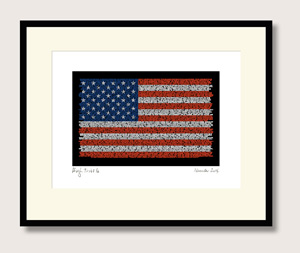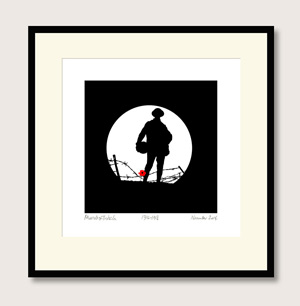
TISDALE & MURRELL Selected Prints, 9-30 April 2016, Swan House Gallery, Harwich
20.04.16
Sanjiv Sachdev reviews an exhibitiion of prints by Philosophy Football designer Hugh Tisdale and Illustrator Dan Murrell
 In ‘Waiting for the Great Leap Forward’ Billy Bragg famously sings that “The revolution is just a T-shirt away”. The phrase now, of course, adorns a Bragg-approved Philosophy Football T-shirt, and captures the subject matter of Hugh Tisdale and Dan Murrell’s exhibition of prints; an interest in music, progressive politics and pop culture in its broadest sense. A small slice of a huge, wide-ranging catalogue is present here, starting in 2000 and ending in 2016, of 20 prints produced in silkscreen, digital and hand-stencilled media.
In ‘Waiting for the Great Leap Forward’ Billy Bragg famously sings that “The revolution is just a T-shirt away”. The phrase now, of course, adorns a Bragg-approved Philosophy Football T-shirt, and captures the subject matter of Hugh Tisdale and Dan Murrell’s exhibition of prints; an interest in music, progressive politics and pop culture in its broadest sense. A small slice of a huge, wide-ranging catalogue is present here, starting in 2000 and ending in 2016, of 20 prints produced in silkscreen, digital and hand-stencilled media.
The T-shirts of Philosophy Football led where many have since followed: sleek, stylish, punchy design married to political and social comment with a sparkle of wit. They use a democratic format of which William Morris would have approved - being both beautiful and useful - but one which is also, unlike that of Morris, affordable. At around £20 each they are within the budgets of most. Well made and well-designed, with double stitching and using heavy cotton, they are not flimsy products, but are built to last. Some designs commemorate and celebrate, others mock and indict. Most but not all of these prints were originally T-shirt designs.
Like a Banksy graffiti, a T-shirt or a magazine cover needs to make an immediate, instant impact to attract attention. They also need visual wit and panache to earn a second, longer look. Most of these prints reflect these aims – they are often visceral and kinetic, with a guitar about to be smashed to pieces or a badger brandishing a smoking gun, Daleks with guns blazing and in demented war-cry, a fighter-plane in full flow or a Mickey Mouse with the menacing grin of a blood-hungry Dracula or the surging, game winning run of a rugby player. Others are idea-led; thus the American Dream and Martin Luther King’s Dream fuse to give a whole new resonance to the stars and stripes; a barcode and the words ‘don’t think, consume’, seemingly redolent of Klein’s ‘No Logo’ arguments, indict empty consumption; the Clash’s scornful rejection of vacuous celebrity worship is caught in DIY punk style, pallette, and typewriter font. Hugh Tisdale says ‘simplicity is my favourite word’ and these pictures are, deceptively, simple with their straight, clear, clean, uncluttered lines.
On closer inspection much thought and care are evident. Influences of art, photography and pop culture abound, be it British, with Constable’s Haywain, via Peter Kennard, and in the wrecked car there are echoes of the car husk from the First Iraq War, now in the Imperial War Museum, the 1940 ‘Few’, Peter Cook, Tommy Cooper, Dr Who, hints of James Bond, the Jam, the Clash, Red Wedge; the US with Laurel and Hardy, Mickey Mouse, Warhol/Coca Cola, Lichtenstein, Martin Luther King, and Jasper Johns; Russian Constructivists, especially El Lissitzky, or Castro in the manner of poster-boy Che. Flags, for the US (which the art critic Robert Hughes claimed to be ‘the most recognised abstraction in the world’) and Palestine, are imbued with the spirit of protest with words using Tisdale’s favoured sans-serif ‘Shire’ fonts.
The printing process often entails the use of a few carefully-chosen colours – three of the pictures use just black and shades of white, another adds a small, eye-catching, daub of poppy-red. Most use three or four. Reproducability is key. A spotlight-like circle is often used to frame a figure – be it a Gatling Gun-totting badger, a Bond-imitating, snarling Malcolm Tucker (whose belligerent pointing finger has the lethal presence of a Walther PPK) or a speeding Hawker Hurricane, where the circle deftly doubles as a propeller in motion – my particular favourite – capturing movement with stillness, using so little.
Given the long and continuing association of football with the work of Tisdale and Murrell, it is a slight surprise that, aside from a World War I football, none representing the beautiful game are in the show. Sport’s sole contribution is a powerful picture of All-Black Jonah Lomu, framed by an exquisite, circular Maori symbol.
The show deserves a wider audience. It reflects and has partly shaped an aesthetic of comment and protest. I hope this is the first of many. ‘Tisdale & Murrell’ is at the Swan House Gallery, 14 Kings Head Street, Harwich CO12 3EE. Open Tues-Sat 10.00am-5.00pm, Sun 10.00am-4.00pm until 3rd May
‘Tisdale & Murrell’ is at the Swan House Gallery, 14 Kings Head Street, Harwich CO12 3EE. Open Tues-Sat 10.00am-5.00pm, Sun 10.00am-4.00pm until 3rd May
Philosophy Football limited editiion prints by Tisdale & Murrell are available for purchase from here